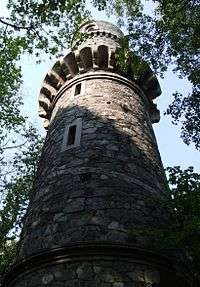Bismarck tower



.jpg)
A Bismarck tower (German: Bismarckturm) is a specific type of monument built according to a more or less standard model across the Germany to honour its first chancellor, Otto von Bismarck (d. 1898). A total of 234 of these towers were inventoried by Kloss and Seele in 2007[1] but more have been discovered since making the total around 240.[2][3] These towers were built between 1869[4] and 1934 and some 173 remain today.[1][5] Quite a few of these towers, including all 47 based on Wilhelm Kreis's Götterdämmerung design,[6] were built as so-called Bismarck Columns (Bismarcksäulen) or were converted into them. This description goes back to the Student Union's competition held in 1899,[7] which was to encourage the erection of as many beacons as possible (and not observation towers). But other Bismarck towers, e. g. those which were purely beacons with no observation function, were often called Bismarck columns.
History
The world's first Bismarck tower now stands in Poland. It was erected by private initiative in 1869 in the village of Ober-Johnsdorf, Silesia, then part of Prussia (now Janówek, Poland). It stands on top of the hill now called Jańska Góra (German: Johnsberg), 253 m above sea level. The tower itself is 23 m in height. The sponsor was a retired Prussian officer Friedrich Schröter (1820–1888), a wealthy landowner in nearby Wättrisch.[4]
One year after Bismarck's death, German Studentenverbindung fraternities chose one of the designs submitted by the architect Wilhelm Kreis in an 1899 architecture competition. The award-winning Götterdämmerung fire column design of granite or sandstone was selected as a standard model for all Bismarck towers. The massive and squat design could be built to different heights and widths depending on the amount of money donated for the particular monument.
In manifestation of the Bismarck cult, they were built in various styles in locations across the German Empire, including its colonies in New Guinea (Gazelle Peninsula), Cameroon (near Limbe) and Tanzania, as well as in areas of Europe that, at the time, were part of Germany, but now lie within the borders of Poland, France, Denmark or Russia. Bismarck towers were also built in Austria, in the Czech Republic, and in Concepción, Chile.
Every Bismarck tower was intended as a beacon. Their braziers were to be lit on specified days in honour of the former chancellor to commemorate his achievement in unifying Germany in 1871. Though most towers included firing installations, plans for a nationwide beaconing failed and many local initiatives chose deviating designs. The architects of these towers included Wilhelm Kreis himself, who built 58 (47 to the Götterdämmerung design), and Bruno Schmitz.
Notable towers
- Aachen, finished in 1907
- Bad Kissingen, 1930
- Ballenstedt, 1930/31
- Hanover, finished in 1904, dismantled in 1935
- Janówek (Ober-Johnsdorf), Poland - the first Bismarck tower, finished in 1869
- Metz, Le Ban-Saint-Martin - the only preserved Bismarck tower in France
- Porta Westfalica, 1902, dismantled in 1952
- Salzgitter, 1900
- Szczecin (Stettin), Poland
- Viersen, 1901
- Wiesbaden, 1910 - with 50 m (160 ft) the highest tower, dismantled in 1918
- Zielona Góra (Grünberg), Poland
See also
References
- 1 2 Pohlsander, Hans A. National Monuments and Nationalism in 19th Century Germany, Oxford: Lang, 2008, p. 226-227
- ↑ Bismarcktürme £ Bismarcksäule at www.bismarcktuerme.de. Retrieved 28 July 2016.
- ↑ Lexikon der Bismarck-Denkmäler by Sieglinde Seele. Retrieved 28 July 2016.
- 1 2 Der älteste Bismarckturm von 1869 at www.bismarcktuerme.de. Retrieved 28 July 2016.
- ↑ , retrieved 28 Jul 2016
- ↑ Geschichte der Bismarcktürme at www.bismarcktuerme.de. Retrieved 28 July 2016
- ↑ Niedersächsisches Jahrbuch für Landesgeschichte. Vol. 82, Hanover, 2010, p. 182.
External links
| Wikimedia Commons has media related to Bismarck tower. |